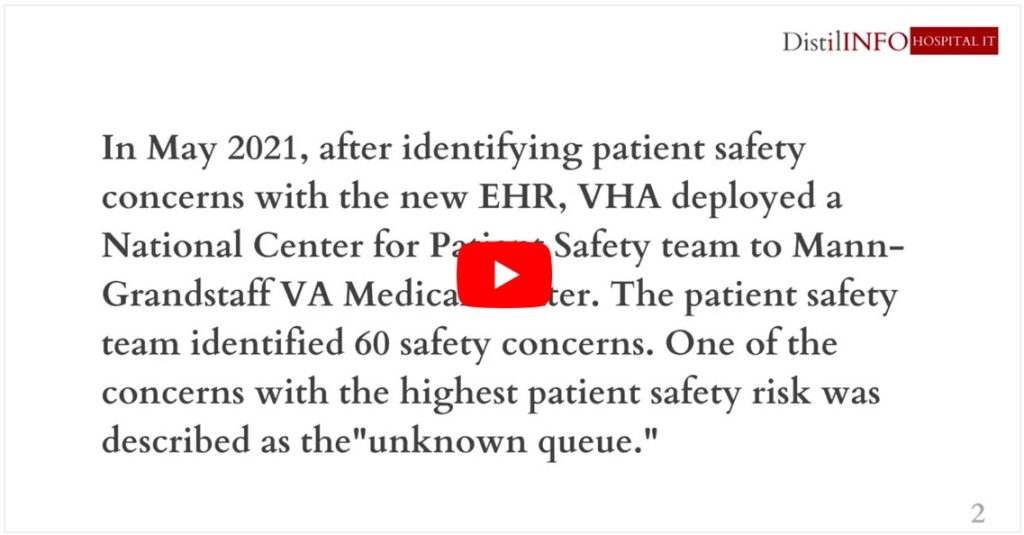
The Department of Veterans Affairs’ new Cerner EHR has negatively impacted patient safety, according to a VA Office of Inspector General (OIG) report.
In May 2021, after identifying patient safety concerns with the new EHR, VHA deployed a National Center for Patient Safety team to Mann-Grandstaff VA Medical Center. The patient safety team identified 60 safety concerns. One of the concerns with the highest patient safety risk was described as the”unknown queue.”

OIG reviewed the unknown queue patient safety risk and found that the EHR sent thousands of orders for medical care to an undetectable location instead of the intended service location.
The EHR allows providers to select locations from a drop-down menu that depending on the specific order, would not be recognized as a “match.” This “mismatch” would ultimately send orders to the unknown queue.
Notably, the EHR did not alert providers that it did not deliver the order to the intended location. From the Mann-Grandstaff go-live in October 2020 through June 2021, the EHR failed to deliver more than 11,000 orders for requested clinical services.
OIG did not find evidence that Oracle Cerner provided information about the unknown queue to VA before the EHR implementation.
On October 28, 2020, four days after go-live, a provider placed the first trouble ticket regarding lost orders, which resulted in finding the unknown queue.
After identifying the unknown queue, VHA instructed staff to cancel and reenter each order in the unknown queue.
“Absent VHA actions, the existence of the unknown queue and the unfulfilled clinical orders may not have been identified, and many patient care orders may not have been completed,” John D. Daigh, Jr, MD, assistant inspector general for healthcare inspections, wrote in the report.
In September 2021, Oracle Cerner responded to VHA concerns by taking steps to remove the unmatched locations. Then, in February 2022, Oracle Cerner updated the EHR with an alert to providers when they attempted to create an order with an unmatched location.
However, in May 2022, a VHA official notified Oracle Cerner that the mitigations were inadequate and had not been successful.
On May 16, 2022, OIG ran an EHR report and found 206 orders in the unknown queue for VHA sites.
OIG contacted facility leaders who reported using the VHA-established process to monitor and remediate the unknown queue and informed them that gaps in the mitigation process could still result in orders remaining in the queue.
“Each facility that goes live with the new EHR will require an ongoing commitment from facility staff to monitor and address the new EHR’s unknown queue,” Daigh wrote.
OIG found that VHA determined the EHR’s unknown queue presented significant risk and caused harm to multiple patients. In late 2021, VHA informed senior VA and Office of Electronic Health Record Modernization (EHRM) leaders about the risk and harm to patients.
VHA initiated a clinical review in June 2021 to ensure that providers acted on orders sent to the unknown queue and assessed patients for harm from delays in care.
The reviewers identified and classified 149 adverse events for patients (2 major harm, 52 moderate harm, and 95 minor harm).
“Based on the multiple events of patient harm, insufficient mitigations that burden VHA staff, and continued risk to patient safety, the OIG remains concerned with the management of the new EHR’s unknown queue,” the report author wrote.
The OIG made two recommendations to the Deputy Secretary related to Oracle Cerner’s failure to inform the VA of the unknown queue and mitigation process.
The Deputy Secretary agreed with recommendations one and two and submitted action plans. However, OIG determined the action plans do not meet the intent of the recommendations.
“The OIG is concerned with many statements and aspects of the Deputy Secretary’s response to the draft report,” the report noted. “Significantly, the Deputy Secretary’s comments failed to address a central finding of the report that the unknown queue led to patient harm. Acknowledgment of harm is a key element to promoting VA as a learning organization.”
Additionally, the Deputy Secretary’s allegation that the OIG’s report “contains material errors or omissions” is not supported, Daigh wrote.
The response from the Deputy Secretary claims that the “history of the program reflects that the purpose and use of the queue were discussed and developed by the joint efforts of both Cerner and VA.”
However, the OIG report supports that Oracle Cerner did not provide VA with any actionable information regarding the unknown queue before go-live.
“The OIG finds it troubling that the Deputy Secretary’s response appears to absolve Oracle Cerner for its failure to inform VA of the unknown queue while placing the blame for outcomes from the unknown queue on VHA end-users,” the report author wrote.
“The OIG remains concerned with the number of patient safety events related to the new EHR but commends the work of those in VHA working to address ongoing patient safety issues,” the report continued. “VHA National Center for Patient Safety continues to identify and address patient safety concerns with the new EHR.”
On July 5, 2022, VHA National Center for Patient Safety leaders provided EHRM Integration Office with reports of EHR patient safety problems and patient harm.
The Deputy Secretary responded that “the primary reason an order may go unfulfilled is human error.” Evidence presented in the OIG report does not substantiate that statement.
“The Deputy Secretary’s response to the report reflects VA senior leaders’ lack of acknowledgment of patient harm caused by the new EHR,” Daigh said.
Source: EHR Intelligence




Leave a Reply